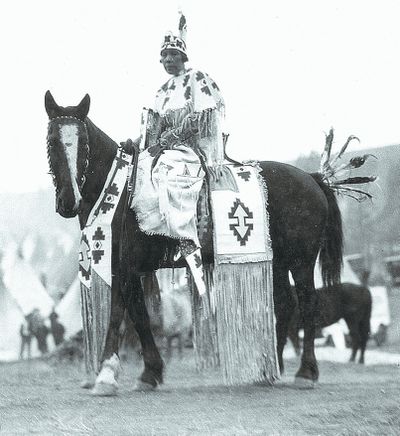Latest MAC exhibit shows off impressive collections from tribes

Now, in its biggest American Indian exhibit ever, the MAC is showing off its holdings in “Lasting Heritage,” running through 2014.
Two large galleries overflow with arrowheads, beaded clothing, gorgeous woven baskets, paintings, historical photographs and more.
The oldest objects: prehistoric stone tools.
The newest object: a 2009 glass art piece by Wasco/Yakama/Warm Springs artist Lillian Pitt.
And the biggest object: a three-quarter size tepee, set up in the middle of the exhibit.
These artifacts and art pieces illustrate the themes that guest curator Miles R. Miller, a member of the Yakama Tribe, first expressed in his 2010 essay for the National Geographic book, “Indian Nations of North America.” He wrote a chapter about the Plateau and Great Basin tribes – how they are similar, how they are different, and how they have survived.
With this exhibit, Miller picked objects from the MAC’s vast storeroom to illustrate those themes. The tribes of this region – Spokane, Kalispel, Coeur d’Alene and Colville – are well-represented. Yet so are more far-flung Great Basin tribes including the Ute, Paiute and Shoshone-Bannock. The one thing Miller hopes visitors will take away: “We are not all alike.”
“The artwork may be similar in the use of materials – the basketry and the beads – but to each of the tribes, how they represented it is different,” said Miller, an independent scholar and beadwork artist.
The baby boards – also called cradle boards or baby carriers – are the most vivid examples. All of the tribes made them, but the boards from the Columbia Plateau tribes were distinct from those of the Great Basin tribes to the south.
“They (the Great Basin tribes) made them almost as a form of basketry,” said Miller. “They weaved willow to create the board, and construct a hood, for lack of a better word, to shade the baby. They’re very different from those used up here in the Plateau region.”
Most objects date from between 1875 and 1910. The MAC’s American Indian holdings come from large donations dating back to the earliest days of the museum, along with the vast collection acquired in 1991 after a merger with the Museum of Native American Cultures.
After the museum was “swept clean” to make room for this summer’s Leonardo da Vinci exhibit, the museum had a chance to re-think “how we present our collection and use our space,” said Laura Thayer, the museum programs manager.
“It gave us the opportunity to think about what our users want,” Thayer said. “And one thing we’ve heard for years: ‘We want more of the American Indian collection.’ ”
The museum’s holdings include plenty of contemporary American Indian art, which is also reflected in this exhibit. You’ll see work by well-known Native American artists, including Pitt and Joe Feddersen. The contemporary art pieces will help visitors to see how tribal culture has changed and how it has remained the same. They also speak to Miller’s third theme – survival. Some of these works are clearly modern, yet reveal roots going back to the petroglyphs.
The survival theme is also evident in some of the older artifacts. Miller was especially taken with an old Nez Perce root-gathering bag, probably dating from 1877, found along the trail after the tribe fled from the U.S. Cavalry. It was made from natural materials including Indian hemp and ryegrass, but also “unraveled” wool taken from a cavalry officer’s uniform.
“And here this bag has survived all of these years, and made it into a collection,” Miller said.
The majority of the objects might be classified as artifacts, but in a way, they are all art, Thayer said. It’s hard to argue with that when looking at the beautifully decorated dresses and other clothing – and even when looking at an array of arrowheads.
“We spent many hours making choices – choosing things for their beauty,” Thayer said.
For Miller, it was a deep excursion into his own roots.
“I grew up in a traditional family,” said Miller, who was born and raised on the Yakama Reservation. “I was surrounded by these objects, these bags, this traditional clothing.”
The MAC’s biggest-ever American Indian exhibit still can’t come close to displaying everything in the collection. Deep in the MAC basement are some 30,000 Native American objects.
“My goal was to show 10 percent of the Plateau Indian collection,” Thayer said. “We didn’t quite hit that mark.”